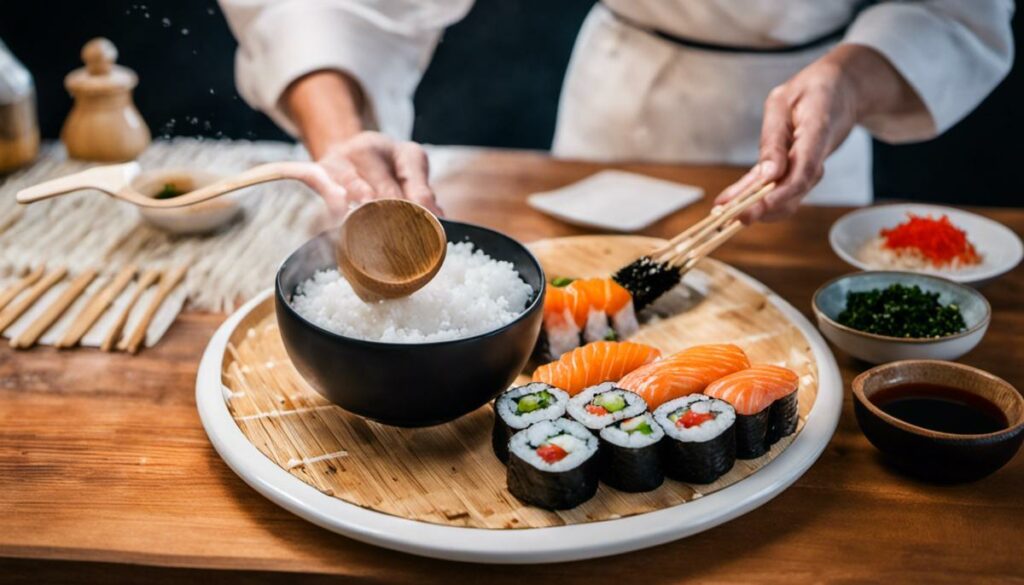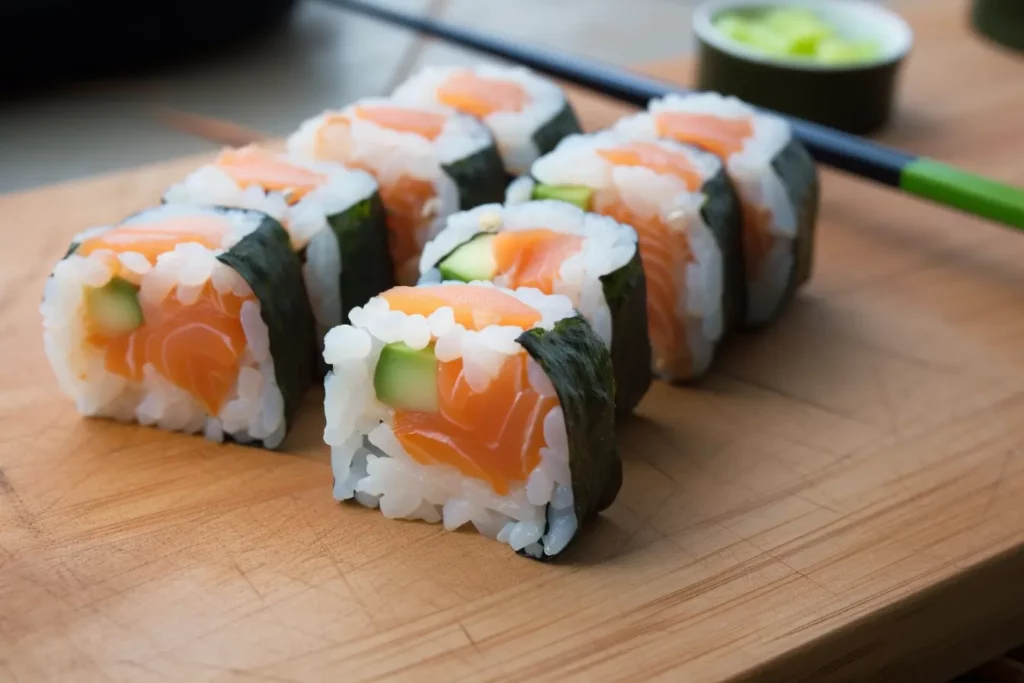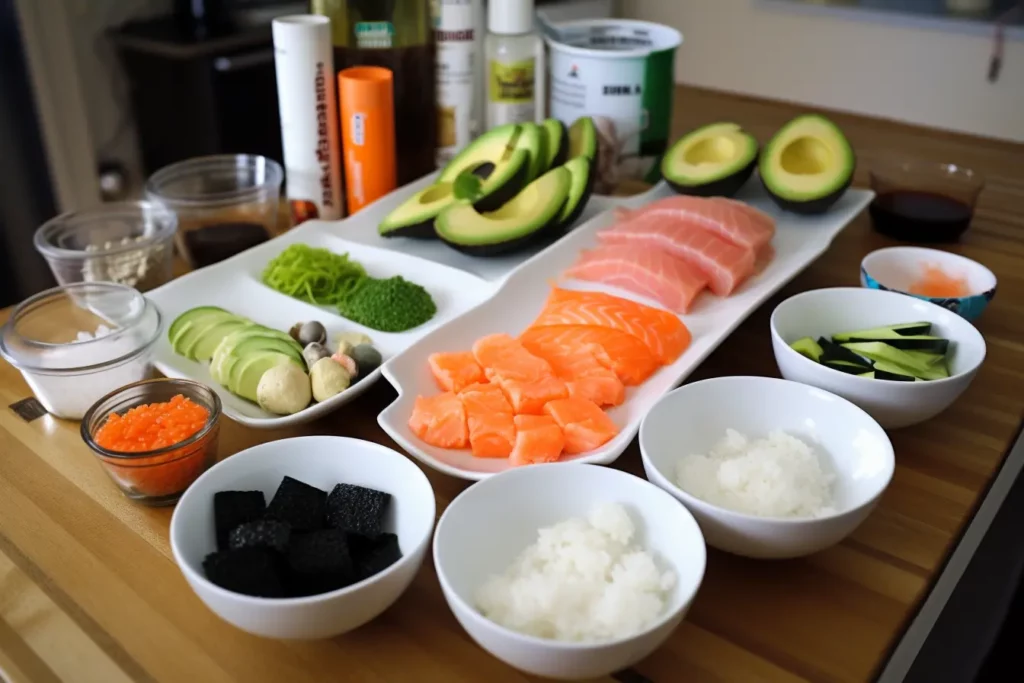Creating sushi rolls is a form of art that requires both patience and technical skills. The beauty of sushi rolling lies not only in the finished product, but also in the process of how to get there. In this essay, we aim to explore these techniques and processes while developing our skills in the art of sushi rolling. We will start by learning how to wash, cook and season sushi rice properly, as this is the basis for any sushi roll. Then, we’ll get acquainted with various traditional and modern ingredients that can be used in sushi rolls and discuss how to prepare them properly. Finally, we’ll look at the techniques for rolling sushi and how to use the bamboo mat to create the perfect roll.
Basics of Sushi Rice Cooking
Stylish, chic and always on-trend, it’s probably obvious that sushi plays a prominent role in a lifestyle composition like this. Whether it’s for a swanky evening with friends or for a quiet moment of indulgence alone, sushi is more than just a dish – it’s an aesthetic. But before we dive into the more elegant aspects of the sushi experience, let’s start with the basics: the perfect sushi rice.
The starting point for the perfect sushi rice is choosing the right variety. The short-grain rice of the varieties “Koshihikari” or “rice pudding” is recommended. These strains have the ideal balance of stickiness and fluffiness to give their sushi that extra something.
This is followed by the crucial phase of preparation: washing. Rinse the rice thoroughly under running water until the draining water runs clear. This meticulous process removes the excess starch and prevents the rice from becoming too sticky. A good sushi rice strives for the perfect balance between cohesion and lightness.
Now it’s time to cook. Add rice to water in the saucepan in a ratio of 1:1.2, bring to a boil and then reduce to low heat for about 15 minutes – and yes, this needs to be monitored meticulously! Because every detail counts when striving for perfection.
Once the rice is cooked, it should be left to rest for about 10 minutes. This is followed by dressing with a mixture of rice vinegar, sugar and salt. This mixture should be well cured to coat the rice and give it that incomparable sushi flavor.
So, and now, with all these tips, the basis for an authentic sushi experience is laid. But remember that sushi is more than just the ingredients and the technique – it’s also about the presentation. So be creative, be brave. And whether you’re creating a traditional nigiri or a quirky sushi roll, don’t forget to garnish it with a dash of love. Because that’s what perfection really is.
Image description: A plate of beautifully arranged sushi rolls, garnished with a drizzle of soy sauce and sesame seeds, placed on a black wooden table.

Preparing Sushi Ingredients
Of course, there’s more to the perfect sushi experience than just the rice. The fillings and side dishes are real eye-catchers and contribute significantly to the taste. Here, we share some of the essential ingredients you need to make a variety of sushi fillings.
Fish and seafood: For nigiri and maki rolls, tuna, salmon, and shrimp are common choices. Make sure that the fish is always fresh and suitable for eating raw. Depending on your location and available resources, there may also be a selection of regional marine animals.
Vegetables: In roll form, as uramaki or futomaki, vegetables such as cucumber, avocado or carrot can be rolled up well. Jalapenos, sweet chili sauce or wasabi add spiciness to the sushi.
Tofu: Not only vegetarians and vegans swear by tofu, fish lovers also often opt for the neutral flavor carrier, which is great with soy sauce.
Egg: Due to its mild taste, the sweet tamago (Japanese scrambled eggs) harmonizes perfectly with the acidity of the rice.
Nori: In many sushi variations, this roasted seaweed forms the protective shell around the rice and filling.
Condiments: Wasabi, soy sauce, and pickled ginger are a must. They form the perfect trio to round out any sushi dish.
The key to success lies in free interpretations and experimentation with ingredients. Because sushi, like fashion, is about individuality and personality. Each has its own unique flavor and you should take that into account when preparing and serving sushi. This is the only way to truly share the ease, fun and pleasure that comes with the sushi experience. Now it’s time to roll up your sleeves and apply the techniques and tips you’ve learned. Good luck!

Techniques for rolling sushi
Next, we enter the world of the indispensable intervention, the rolling up of the sushi. When looking at our raw material, it is important to take a mindful approach. Every ingredient, every detail contributes to the final composition.
Before we start rolling up, we need a sushi mat or “makisu“. This technical support is made of braided bamboo sticks and cotton cords and is an essential part of rolling the sushi perfectly.
The provision of the nori seaweed is the initiation rite in this procedure. Place a sheet on the Makisu mat, glossy side down. A delicate layer of sushi rice is now placed on top, up to the edge, but leave about 2 cm free on the opposite side – an empty strip for the final closure of the roll.
Now the main focus is on sushi’s beloved protagonists, the filling. Be it carefully selected seafood, crunchy vegetable strips or velvety-soft tofu – the combinations and variations know no bounds. Place the ingredients along the center of the rice.
And now, the moment of holding your breath, rolling up the sushi. Using the Makisu mat, gently but firmly roll the nori sheets over the filling, making sure no ingredients fall out of the page. Keep gently pulling the mat back to avoid it getting incorporated into the sushi roll.
Once the roll is ready, moisten the left nori strip to seal the roll. Then let the roll rest for a few moments before cutting it with a sharp, damp knife. This way, the presentation is not affected by unsightly cut edges.
The key to a successful sushi is patience and precision. It is a dance between form and aroma formed by the careful composition of ingredients, presentation and craftsmanship. It is an invitation, a dialogue between what is on the plate and those who enjoy it. It invites creative freedom, as well as the depth of tradition. But again, back to the essence – it’s a treat for the senses. Whether as part of a society, branding, or a very personal experience, sushi is always greater than the sum of its parts.
Don’t forget to complete the perfect sushi experience with a touch of wasabi, a drizzle of soy sauce, and maybe a piece of pickled ginger. And dare to experiment with ingredients of your choice – in the end, a chef is as unique as his creations.

After mastering the art of washing, cooking, and seasoning sushi rice, familiarizing ourselves with a variety of ingredients, and learning how to wrap them in a perfect roll, we are at the end of our journey. But this is just the beginning of our advanced journey into the world of sushi rolling. Always remember that practice makes perfect. So get your bamboo mat, rice, and ingredients ready and start rolling. Sushi isn’t just about the final product, it’s about the process we’ve experienced on this journey. With the knowledge and skills gained here, it’s time to create your own creative and delicious sushi variations and share them with others.


